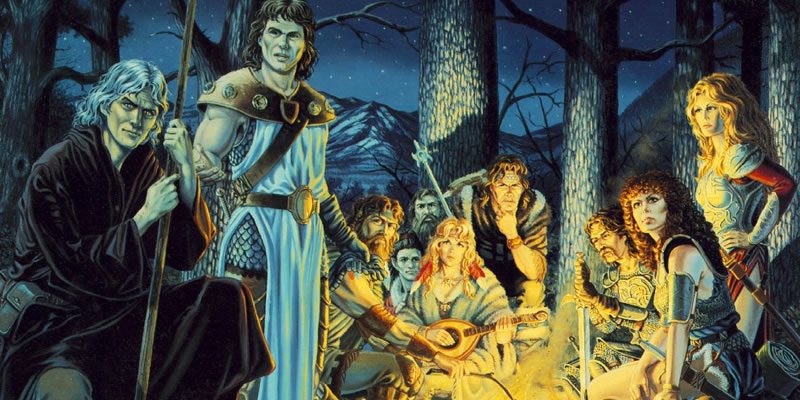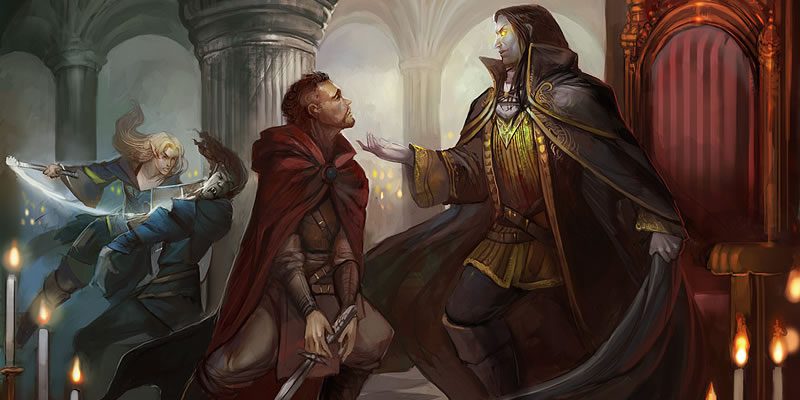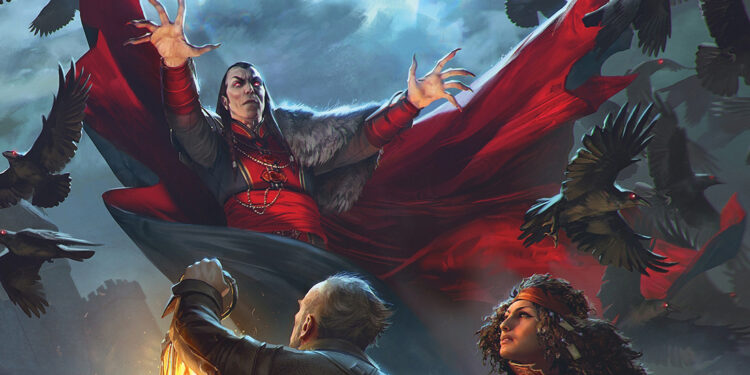
“The mists of Ravenloft are rising. Overcome your dread or forever be its prisoner!”
Van Richten’s Guide to Ravenloft is now available everywhere (release date May 18, 2021) for US$49.95. This 256-page hardcover book includes “everything you need to craft a horror-themed campaign” and greatly expands beyond the gothic horror of The Curse of Strahd. You’ll find 30 Domains of Dread with 30 villainous Darklords, with domains that include vampires, twisted fairy tales, flesh golems, zombies, mad science, and more. The book also has player options and a 20-page adventure called The House of Lament. By the end of this review, I hope you’ll have some idea of what’s in the book and if you should you buy it.
Who is Van Richten and why is the book named after him?
Before we get started, let’s answer this important question…
Dr. Rudolph Van Richten is a vampire hunter who appears in many Ravenloft modules and has written several books about its inhabitants. Previously published books using Van Richten’s name include Curse of Strahd, Van Richten’s Guide to Fiends (1995), Van Richten’s Guide to the Created (1994), Van Richten’s Guide to Werebeasts (1993), Van Richten’s Guide to Vampires (1992), and Van Richten’s Guide to Ghosts (1992). I’m sure you can see a pattern here.
This book begins with some correspondence between Van Richten and those closest to him, but he doesn’t host this book to the same degree as Volo, Tasha, or Xanathar.
Covers
This book, like most releases, is available with the standard cover or an alternative cover found in local gaming stores.
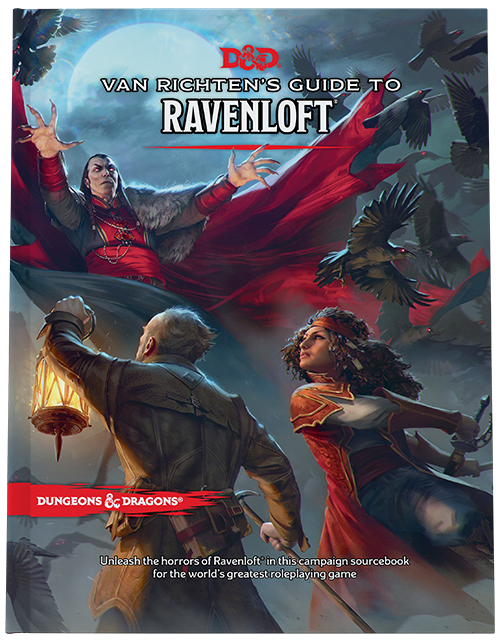
Main Cover by Anna Podedworna
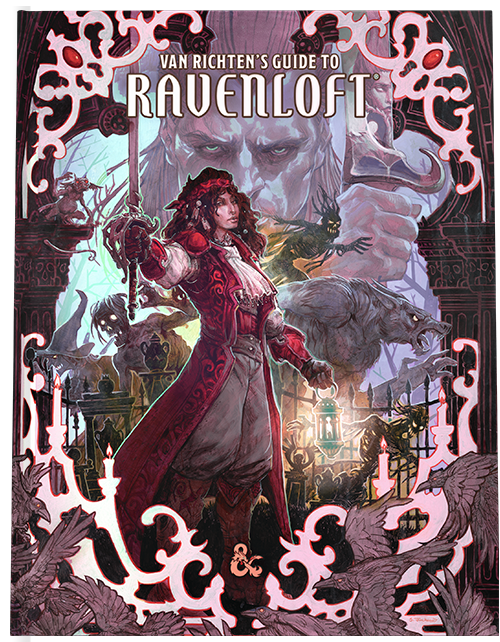
Alternative Cover by Scott M. Fischer
What’s inside Van Richten’s Guide to Ravenloft?
Getting Started
As with past books, readers shouldn’t be surprised to find an introduction and text dedicated to how to use this book. You’ll also find “7 Secrets of Ravenloft” which provides readers with an idea of what makes the setting unique. The rest of this introductory section provides overall explanations for Domains of Dread, Darklords, and how to place adventurers in Ravenloft (through the mists from outside Ravenloft or by rousing locals to take on the call of adventure).
Haunted Heroes
Chapter 1 provides advice and options for players to create and play PCs that fit a horror campaign. While the page count of player options is much less than Eberron: Rising from the Last War, this chapter is similar in size to what’s found in Mythic Odysseys of Theros and Guildmasters’ Guide to Ravnica. Most of the player-facing content is new, with some reprinting of content previously found in The Curse of Strahd. The chapter begins with useful and welcome advice for players of horror games that includes focusing on the game to help with atmosphere, limiting comedy, and notes on respecting the limits of yourself and consent of other players.
Let’s look at the rest of the player content:
LINEAGES
These new racial options are presented as lineages that are meant to be used to modify a character’s starting race via a remarkable event or even return a PC who dies back to the campaign. The three options are the vampiric Damphir, mystical Hexblood, and semi-undead Reborn.
DARK GIFTS
These feat-like options provide PCs with a mechanical feature in exchange for a dark bargain. Players can choose a Dark Gift when they create their character or DMs can offer a particular Dark Gift mid-campaign.
SUBCLASSES
- Bard: College of the Spirits – Play a spooky bard who can channel spirits to empower themselves and their allies through ghost stories. The main mechanic here is to spend a bardic inspiration die to roll on a random table of Spirit Tales which provides ways to hinder enemies or help you and your allies.
- Warlock: The Undead – Play a warlock whose patron is a powerful undead who shares its secrets with you. Why wait to be a lich at level 20 when you can take your first steps starting at level 1.
BACKGROUNDS
- General background features are provided which can be swapped for the feature of any background that includes the Inheritor, Mist Wanderer, Spirit Medium, Trauma Survivor, and Traveler.
- Horror Characteristics provide d12 personality traits, ideals, bonds, and flaws tables to roll on and replace those from your background.
- Haunted One – Reprinted from The Curse of Strahd and provides an option for a character who has experienced a harrowing event that has deeply impacted them.
- Investigator – Not to be confused with the City Watch variant of the same name found in Sword Coast Adventurer’s Guide, this full background provides an option to create a PC that seeks the truth hidden in shadow.
TRINKETS
The Horror Trinkets table is reprinted from The Curse of Strahd
Creating Domains of Dread
Chapter 2 explores how DMs can create their own Domains of Dread and Darklords. This chapter begins with some advice to flesh out your Darklord’s backstory and build out your domain’s specifics. The chapter then moves beyond gothic horror and looks at all of the subgenres that you can draw on to create your little piece of Ravenloft. The subgenres include body horror, cosmic horror, dark fantasy, folk horror, ghost stories, and gothic horror. Each of these six main subgenres gets a two-page spread with a summary and random tables, while the remaining four (disaster horror, occult detective stories, psychological horror, and slasher horror) get a column each. This is excellent content and will really help a DM trying to figure out which type of horror or combination of subgenres they are interested in and provide help to build out their domain.
Domains of Ravenloft
You’ll find over 120 pages of setting details with most of the page count dedicated to 30 featured Domains of Dread that can be found in Ravenloft. The chapter begins with a look at how Ravenloft works, with details on the mists, Ravenloft’s place in the multiverse, and general life in Ravenloft for its inhabitants. The famous gothic horror domain of Barovia is here with Darklord Strahd, but there are 29 other domains and Darklords to learn about. While some entries are briefer than others, most have a map provided and you’ll find unique locations, random tables, and other bits to throw at your players. What you won’t find are any stat blocks for the Darklords, which pushes DMs towards running the Darklords with a focus on story versus combat. As with the previous chapter, support for horror subgenres goes beyond gothic horror and the settings shift across the subgenres with body horror, cosmic horror, dark fantasy, folk horror, and other subgenres all found in some form across the various featured domains. For those who are already fans of Ravenloft, you’ll find domains with lots of familiar bits and others changed quite a bit.
Horror Adventures
Chapter 2 was focused on creating your domain and this chapter is focused on running terrifying adventures in your domain (or anywhere). There’s lots of content here and this chapter offers DMs with tools and rules that include creating curses, fear and stress, haunted traps, survivors, and using Tarokka decks and spirit boards (included as an appendix). The book importantly provides advice on handling horror to keep everyone safe by avoiding phobias and anything else that could ruin the game for a player. The chapter finishes off with an 20-page starter adventure, “The House of Lament” which aims to get a table running a horror campaign before jumping into a Domain of Dread.
Monsters of Ravenloft
The chapter starts out with advice for taking previously published monsters to make them fit Ravenloft, how to describe monsters and what tactics to use to create terror (and really how to run better encounters for other genres too). The monsters chapter contains a solid 30+ stat blocks. All of the stat blocks looked new to me, but I might have missed a monster or two with all the books out these days. As with chapters 2 and 3, you’ll find support across horror subgenres and some of the monsters are pretty horrific and terrifying. While you’ll find more standard stuff like swarms of maggots, headless horsemen, and zombies, you’ll also find some unique stuff such as the brain in a jar, the carrionette (doll on a unicycle), and customizable unspeakable horrors.
Who should buy Van Richten’s Guide to Ravenloft?
Anyone who is a fan of the horror genre or enjoys running creepy, spooky, and/or terrifying games.
- Anyone who enjoyed running or playing in the The Curse of Strahd
- Players looking to create haunted characters with 3 lineage racial options, 2 subclasses, and various horror-themed background options
- Dungeon Masters looking for a variety of mini-settings across the many subgenres of horror
- Dungeon Masters looking to create their own Domains of Dread and their own Darklord
- Dungeon Masters looking for a shorter horror-themed adventure to get started before diving into a Domain of Dread or even The Curse of Strahd
- Dungeon Masters looking for a toolkit filled with advice, optional rules, and monsters to support horror campaigns
Who Should Avoid the Book?
This book is excellent, but if the horror genre (and its many subgenres) isn’t your thing – you’re better off sticking to the more typical D&D sourcebook. If you are looking for stat blocks for all of the super powerful Darklords, you’ll need to look elsewhere, as you won’t find it here.
Overall Thoughts
This book is both an excellent setting sourcebook and horror toolkit. With over 120 pages of Ravenloft setting details, this book provides plenty of setting content. The covers and interior artwork are excellent and really help with the atmosphere, but it’s the content that stands out the most in this book. For players and dungeon masters looking to jump into a horror campaign with a little help, there are plenty of options to support both with character options, advice, tools, and monsters.
All of the player options (new or old) are solid and on theme. While there are new racial and subclass options, much of this section is spent on providing support for roleplay-based mechanics with Dark Gifts and multiple ways to create a background to fit the genre. The new racial options are presented as lineages and are meant to modify a character’s starting race or even return a PC who dies back to the campaign. The subclasses fit the genre well, with a ghost story powered bard and a baby-lich warlock. I like that there are options that allow for a tough campaign with the death of a PC being the potential start of another chapter in the character’s story with the Dark Gifts and Reborn lineage.
As for Dungeon Masters, they get a toolkit to build horror adventures. The book provides an array of 30 settings spread across the various subgenres of horror. DMs who want to create their own horror setting are well supported and they’ll find advice and rules to run horror adventures, create their own Domain of Dread and Darklord to inhabit it, and horror-themed monsters to terrify players. DMs will also find a “starter adventure” to run before jumping into a Domain of Dread found in the book or of their own creation.
Disclaimer: The reviewer was provided a free review copy of this book by the publisher’s press agency before the release date.

